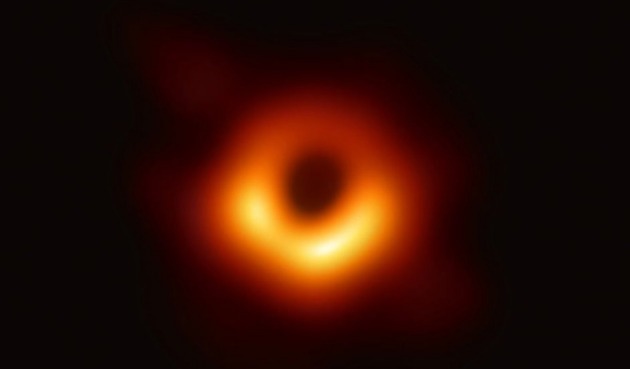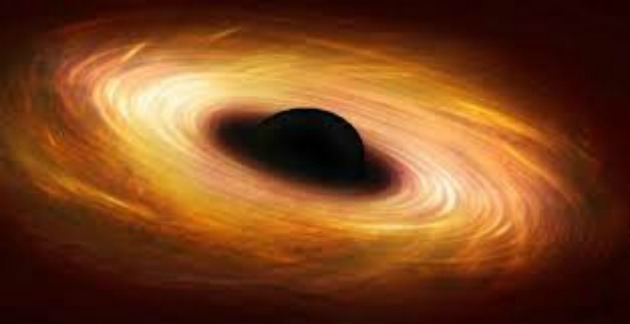Black holes are places in space whose escape velocity is greater than the speed of light. In these regions there is an intense gravitational field and matter stored in very small spaces.
The concentrated mass of a black hole can be up to 20 times that of the Sun. Size, however, varies; there are big and small, and scientists are betting that there are black holes the size of an atom.
As its gravitational field is so intense, not even light can escape. In this way, they are invisible and it is not possible to estimate the amount existing, for example, in the Milky Way.
First Image of a Black Hole (2019)
In April 2019 scientists presented the first photo of a black hole, which is located at the center of the Messier 87 (M87) galaxy.
The mass of this black hole is 6.5 billion times that of the Sun and its distance from Earth is 55 million light years.
In the image, we see a glowing ring around a dark center. This ring is the result of light that bends around the black hole due to its strong gravity.

This image was obtained through 8 radio telescopes spread over different parts of the Earth and that are part of the Event Horizon Telescope (EHT) project.
How is it possible to "see" a black hole?
Although they cannot be seen directly, the behavior of the surrounding stars indicates the presence of a black hole because gravity affects the stars and gas present in the vicinity.
The intense gravitational force of black holes captures the gases that are nearby and these gases when being sucked have their gravitational potential energy gradually transformed into kinetic, thermal and radioactive.
The trajectory described by the gas towards the black hole is shaped like a spiral and along the way photons are emitted, which escape before reaching the black hole threshold.
This emission forms around it a bright ring, which allows its indirect observation and represents the visible part in the first image captured of a black hole.
Types of black holes
Black holes are classified as stellar or supermassive. The small ones are called stellar and the largest ones are called supermassive and can have the mass of 1 million suns together.
Studies by NASA (US Space Agency) indicate that every large galaxy has a supermassive black hole at its center.
The Milky Way is home to a supermassive black hole called Sagittarius A, which has an estimated mass of 4 million suns.
The assumption is that supermassives were formed at the origin of the Universe, while stellars result from the death of a supernova star.

The Sun should not turn into a black hole because it doesn't have enough energy to change current gravity.
Black Hole Theory
For a long time it was believed that the speed of light it was infinite. However, in 1676, Ole Roemer discovered that light travels with finite speed.
This fact led Laplace and John Michell, at the end of the 18th century, to believe that they could exist stars with a gravitational field so strong that the escape velocity was greater than the velocity of the light.
THE Theory of relativity Albert Einstein's general presented the force of gravity as a result of the deformation of spacetime (curved space). This paved the way for theoretical framing of the existence of black holes.

In the same year as the presentation of the famous study of the theory of general relativity, the German physicist Karl Schwarzschild he found the exact solution of Einstein's equation for massive stars and related their rays to their pastas. Thus, he mathematically demonstrated the existence of these regions.
In the early 70s, Stephen Hawking he began researching the characteristics of black holes.
As a result of his research, he predicted that black holes emit radiation that can be detected by special instruments. Discovery of it made possible the detailed study of black holes.
Thus, with the development of telescopes that measure X-ray emitters from star sources, it became possible to indirectly observe black holes.
The Sagittarius Black Hole A
Scientists estimate that elliptical and spiral galaxies - like the Milky Way - have a supermassive black hole. This is the case for Sagittarius A, which is 26,000 light years from Earth.
Excess cosmic dust in the galaxy prevents observation around Sagittarius A. Unlike other celestial bodies, which emit light, black holes cannot be observed by the usual methods. Thus, the work is carried out through radio waves and X-rays.
giant black hole
The largest black hole is 12 million times as massive as the Sun. The discovery, made by Chinese scientists at Peking University, was released in 2015.
A black hole is at the center of a galaxy - just like supermassives.
Scientists estimate that it was formed 12.8 billion Earth years ago and has an amount of light 420 trillion times greater than the Sun.
From the collision of two black holes, it was possible to prove the existence of gravitational waves.
Read more about the topic:
- Big Bang Theory
- Gravity
- What is Universe?
- 5 theories about the origin of the universe


